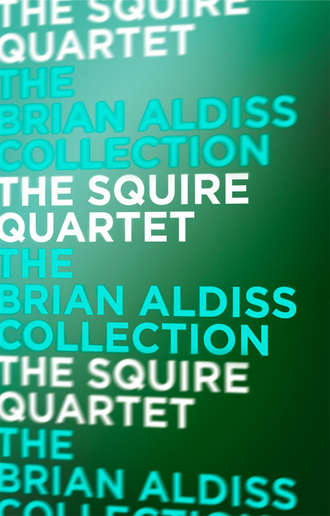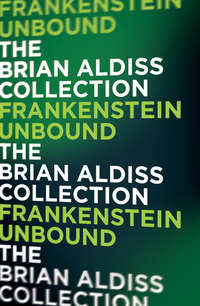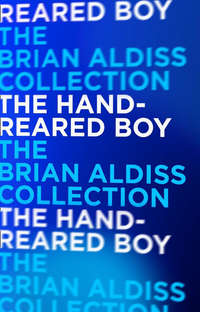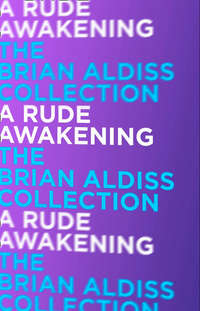
Полная версия
The Squire Quartet

BRIAN ALDISS
The Squire Quartet
Life in the West
Forgotten Life
Remembrance Day
Somewhere East of Life
Part of the Brian Aldiss Collection

Table of Contents
Cover
Title Page
Introduction
Life in the West
Forgotten Life
Remembrance Day
Somewhere East of Life
About the Author
Copyright
About the Publisher
Introduction
The Squire Quartet
Originally, these four novels had a curiously remote relationship. Their writing was scattered over fifteen years; I wrote other books in between. I also spent much time putting together anthologies of other writers whose stories I admired and felt they deserved a wider audience.
The scenes are set here and there, concluding mainly in two countries, Georgia and Turkmenistan.
Georgia I had visited, and felt I knew pretty well. At the time, I had a researcher, who dug into the Great Soviet Encyclopaedia. She discovered that Turkmenistan had at its heart the image of a poet, Makhtumkuli. It was as if the column in London's Trafalgar Square had at its summit not Nelson but Philip Larkin!
My curiosity was awakened. I had the good fortune to find in the city of Reading the jovial Dr Youssef Azimun, who had once been Minister for Culture in the Turkmen government. I also found that his wife was a wonderful cook. In no time, I accompanied Youssef to Ashkhabad.
During that period, I was having problems with my literary agent. He worked in London, I in Oxford – thus I had little opportunity to strangle him. This perhaps explains why the four Quartet volumes, in England at least, were published successively by four different publishers. They were for that reason never considered, never weighed up, as a Quartet. Yet they strive together to embrace the world in which we then lived.
It is clear that the four books cover a lot of ground and time and tone; such was my life then that this was partly by design, partly inadvertence.
I did come to regret that Tom Squire did not play a greater role in the later volumes; possibly I felt this to be an echo of my own career.
Eventually, I made what must pass for amends. In a volume I wrote later, which deals with the EU forty years on (entitled 'Super State'), there is a passage where, on a sad and rainy day, Squire's body is buried, his coffin choked with wreaths and flowers. A reception is held afterwards in Pippet Hall.
Squire was a good liberal man. Maybe I underestimated him.
BRIAN ALDISS
Life in the West

Dedication
Life in the West is dedicated to other
Distinguished Persons
Chen, David, Iris, Maysie, and Michael
by no means forgetting Felix, Elena, Derek, and Janet
to show them what one of their number was up to
before we sampled life in the East
and walked the Great Wall together
Contents
Title Page
Dedication
Introduction
Prelude
1 The International Congress
2 Flattery and Higher Foolishness
3 A View from the Beach
4 Conversation with ‘Drina’s’
5 She’s Only a Sex Symbol
6 Putting our Socialist Friends to Rights
7 Land Full of Strange Gods
8 Sublimated Coin Warfare
9 How to Get to Ostrow Lomelsky
10 Slatko
11 ‘The Strong Act as They Have Power to Act’
12 Tribal Customs
13 Illegal Currency Charges
14 An Ideological Decision
Acknowledgments
I walked beside a sea aflame,
An animal of land. The fire
Of stars knocked at my earthbound frame:
East of grapples West, man maid, hope Fate;
All oppositions emanate
From constellations of desire.
Burning below hair, flesh, and teeth,
An image of the Bright Ones lies,
A lantern hid in bone. Beneath
That vision, teeth and hair begin
Again; wolf grins to wolfish grin
As smile I in my lover’s eyes.
Too soon that love with false-bright hair
Is dead: the house stands silent. I
Fare forth across the world’s despair,
Its muteness, oratory, and banners,
To seek not truth but modern manners.
The head must win what heart let die.
Introduction
When I began to write the Squire Quartet my intention was to portray something of the world I was living in, from the 1980s onwards. I found most of that world exciting – enticing to experience and to record.
This, the first volume of the Squire Quartet, brisk and chatty, was published on March 6th 1980 – as a loving card from my wife, still tucked into her copy of the book, reminds me. We were living on a quiet North Oxford street and our younger children were seriously into education. We were always moving house, depending on our fortunes.
I had been attending a conference in Palermo – a conference with a strong Communist flavour, not particularly enjoyable. It was over. I was standing on the dockside, looking north over the sea. A story began to build up in my mind: the conference; the players from various countries, where the economic blocs seemed irreconcilable; and at the same time, a man’s – Sir Thomas C. Squire’s – difficulties at home.
Once I returned to our house in Charlbury Road, I launched into the novel. My mother died during that period; a melancholy event recorded when Squire’s mother dies just before Christmas. You have to go on, whatever happens. Maybe the army taught me that. Or maybe I had known it even as a small boy. Anyhow, Squire also has to press on. Trouble in Yugoslavia, where he is almost killed. Separation from Teresa, his wife. More human experience, more meditation. More striving to penetrate the thickets.
The novel opens with Squire in Ermalpa, Sicily, for a conference on the popular arts, dubbed ‘the arts of no refinement’. He claims that the pop art of one generation becomes the classic of the next: ‘Homer was, in his day, the Bronze Age equivalent of the TV soap opera.’ Squire is for the new, insisting we rise up to change.
Later, back at his Norfolk house, Pippet Hall, Squire is filming and being filmed. The traditional pretty girl in a swimsuit is with him. He remarks, ‘We are all symbols to each other as well as real people.’
It is the period of the Cold War – much discussion takes place. Squire and his wife quarrel bitterly.
Squire recalls a note given to him in Ermalpa, in which Vasili Rugorsky, the friendly Russian, proposes they visit Nontreale’s cathedral and that Squire pay the bus fare: ‘our government keeps us poor as saints.’
They get to Nontreale and enter the cathedral. Rugorsky praises the elaborate artwork. He says to the unimpressed Squire, ‘Without God, I can see no meaning in anything.’
‘Do you ever experience the feeling that you have come to a dead halt in your life?’ Rugorsky asks.
So the questioning goes on, the faltering marriage, the symbols, the seasons, life itself …
Brian Aldiss
Oxford, 2012
Prelude
Spring 1977
A period in the history of the West known as the late nineteen-seventies. One of the milder inter-glacial periods, when textbooks describe the North European climate as ‘pleasantly cool and damp’.
Over the European Economic Community, eight o’clock of a windy and rather chill spring evening. Television screens brighten everywhere, in flats, houses, and apartments stretching from Scapa Flow to the Gulf of Otranto. Hundreds of them, thousands, millions, the characteristic burning to ward off the terrors of ancient night. So characteristic that future historians will refer to this cultural epoch as the Rounded Rectangular. The global village enjoys its nightly catharsis of violence or Kultur.
The light brightens. Music, and the sight of a savage tropical landscape. The peaks of mountains covered with rain forest stand out against a fast-moving sky. The forest also appears to move, crawling across the screen as if its trunks were a myriad legs. It sweeps beneath the viewer. A river is revealed, dark-flowing, hemmed with sand.
As the viewpoint sinks, a long-boat is revealed, pulling in to one of the banks of the river. Six tourists climb ashore, gazing up at a towering and broken cliff face. From every cranny of the cliff, trees and creepers grow. At one point, tangled creepers hang down into the water.
The viewpoint moves in to reveal the boatman in close-up. He is a lean and aged Dayak, with a polished brown countenance, a wrinkled forehead, and hollows at cheeks and temples. He rests his hand upon a no less worn wooden post which marks the start of the ascent up the cliff.
Floating down, the viewpoint rests upon the Dayak’s arm and hand.
On his wrist is an LC digital quartz timepiece and calculator. Its case, finished in gold and stainless steel, glints in the sunshine. With its perimeter punctuated by studs, it resembles momentarily, in the dazzle of its reflection, some armoured insect from a much earlier period of Earth’s history. But a slight move of the boatman’s wrist, and the six square ceaseless digits are revealed. They grow larger, writhe into red letters. The red letters come swimming forward to fill the screen, forming the legend:
FRANKENSTEIN AMONG THE ARTS
The party moves from the boat, trudging through the sand with their heads down. They climb the cliff by a winding path from which lizards scurry. Cloud shadow comes and goes. The tourists walk along a raised plank walk through dense primary forest, often having to brush creepers aside. The detached voice of Thomas Squire is heard.
‘We’re in some of the oldest jungle in the world, older than the jungles of the Amazon or the Congo. Successive Ice Ages, which caused so much change elsewhere, had no effect on this luxuriance. Listen to its rich silence – you can hear the murmur of antiquity. Transitory-seeming things like silences and pollen have proved themselves capable of enduring over millions of years.’
As his voice lapses to allow the voice of the jungle to take over, another legend swims into view:
Episode One:
Eternal Ephemera
The party of tourists continues deeper into the forest, emerging suddenly under a ravaged hillside. They pause; they are seen to be of mixed race, two Caucasian, the others Mongoloid; all are dressed similarly, male or female, in comfortable travelling clothes. They walk towards a strangely-shaped cave resembling a whale’s mouth. Stalactites and fallen stone about its rim reinforce this impression and give the appearance of teeth, broken but still functional. One by one, the party moves into the great mouth.
‘We are entering the limestone mountains of a part of Malaysia called the Tinjar National Park. Few tourists from the West ever visit here. These caves are dangerous. Not only do they shelter snakes, bats, and a spiteful variety of centipede, but there are concealed abysses on the cave floors, down which an unsuspecting traveller can drop, sometimes for hundreds of feet. Despite these dangers, when we enter here, we are coming into one of the most ancient homes of mankind.’
From inside the whale’s mouth, the foliage outside appears pale and translucent, like spray off a sea. From a deep darkness into the light, bats begin to pour, more and more of them, flying like leaves in an October wind, ceaselessly.
‘Human beings, homo sapiens, lived in these caves 40,000 years BC, at a time when the last Ice Age had its grip on Europe, and the draughty caves of the Dordogne sheltered our remote forebears. In that long period of time, these bats have not changed in any way, as far as we know, while mankind has changed in so many remarkable ways that we often forget that we have also hardly changed at all.’
The bats continue to pour out into the daylight, thousands upon thousands of them, and still no cease to their numbers. The rustle of their wings follows the viewpoint into the throat of the cave, which is uncertainly illuminated by a floodlight.
‘In terms of centuries, a human life is ephemeral. The things we do, the things we make, our alliances and enmities, are even more ephemeral. These paintings were executed one forgotten day thousands of centuries ago.’
In the uncertain light, faces loom, bodies of men, animals, bright fish, plants, all in mysterious relationships and preserved under a glistening film of limestone. Then the light dies. Something can still be seen in the darkness; it is the liquid crystal display of the boatman’s watch, on which the seconds flit rapidly by.
‘These paintings were not intended to last. Perhaps they were intended to please or function – whatever that function was – just for a day. They are beyond taste. There is an old saying, it is “De gustibus non est disputandum”, meaning, “It’s useless to discuss questions of taste”; yet this series of programmes is designed to discover more about taste, and why and how taste changes.’
Further in the cave, the light reveals pictures of two lizards, curving their bodies round bosses of rock. One lizard is green, one red.
‘Did the prehistoric painter prefer green to red? Some gentlemen prefer blondes, some black-haired beauties. There is always a reason for our preferences, sometimes an important reason. We may prefer Beethoven to Burt Bacharach; there may be a political reason why we like rock’n’roll more than Ruddigore. Are the reasons why a church moves us more than a warehouse purely religious? What makes us read one sort of book in preference to another, or flip from one TV channel to a practically identical one?’
More lizards, and a strange creature that is a kind of man with a tail, or else an anthropomorphic lizard.
‘Nothing like this imaginative creature exists in the caves of Europe. Nor do we find in these paintings that emphasis on hunting which is so pervasive in the caves of Europe. It is almost as if a marked difference between the thought of the East and the West existed all those thousands of centuries ago, even as it exists today. Could the greater passivity of temperament in the East relate to the absence in this part of the world of large animals of the hunt which were common throughout Europe? We can as yet hardly formulate such questions, never mind answering them. In the middle of the twentieth century, we still stand in the middle of unfathomed mystery.’
Darkness, then light again, light moving into a larger cave, where stalactites and stalagmites come together in great folds, like closing teeth. One wall is covered with the outlines of human hands. The hands are all open, palms facing towards the spectator, hundreds of them, stretching up into the darkness, interspersed with strange squiggles reminiscent of intestines. The light moves slowly. The hands continue, palms glistening from their coating of limestone; countless hands, one gesture.
‘We don’t know what these hands mean or meant. They symbolize man – the prehensile fingers, the opposed digit. They reach out to us, as if in supplication. We cannot touch them.’
He places his hand against one of the painted hands. His own palm glistens when he withdraws it.
‘Time and limestone intervene between us. I know nothing more poignant than this wall of hands.’
The hands thin out at last. The wall becomes rougher. The light dims. Someone’s shoulder gets in the way. The music is sombre, romantic, cool, Borodin’s ‘Steppes of Central Asia’ strained through a synthesizer, with acoustics added. Crimson, such as hides behind eyelids, fills the screen; from it, a narrow corridor emerges, and large shattered stones which could have been brought here from outside.
Bones lie in a recess, in the wall. Squire’s hand reaches down and lifts up a skull from which the bottom jaw has dropped away. The forehead gleams, shadows lie in the eye sockets.
‘We can admire the aesthetic qualities of this extremely functional object. However, we would be less appreciative if we knew this to be the skull of a brother who had died only last week. Why is that? Are there degrees of being dead? Perhaps there are even degrees of being alive – we all know that some people are more lively and alert than others. Perhaps the life force is less democratically distributed than we suppose.’
A bright green beetle runs out of one of the eye sockets as Squire lowers the skull to the floor.
‘Let’s ask no more questions for the moment. I believe the answers to a lot of trivial-seeming questions to be profound, to concern politics, life and death, religion, and to lead directly to our imaginative perception of the world. A T-shirt advertising Coca-Cola holds a key to the wearer’s personality: we move from casual preference to the prevailing winds of the individual psyche.’
The viewpoint swings. Now we are returning to the light of day. The members of the party are revealed as six blundering figures, their hands touching the walls for security. This is the throat of the whale, through which bats still whistle like a dark outgoing breath. A patch of daylight ahead is an undersea green.
‘We like to imagine that the men and women who lived and died here 40,000 years ago were haunted by symbols, taboos, superstitions, omens. Yet the same must be said of us today, although our lives in the twentieth century are fortified by elaborate cultural superstructures. Interplay between superstructure and individual is complex. Do we like China because it appears friendly, fear it because it is large, mistrust it because it is communist, or idealize it because it is remote? An individual must choose between cultural superstructures.’
One of the party, a woman in jeans, has stumbled. She bends so that we see she has a badge pinned to her hip pocket. The legend on the badge reads, ‘Friends of the Earth’.
‘In the last two centuries, an infrastructure of man-made objects has proliferated. Mass-produced goods are everywhere, from badges to weapons of destruction, and we find it oddly difficult to pronounce upon them; their very plenty seems to ensnare judgement.’
The speaker produces from his pocket a slender box of matches. The box is black, simply embossed with a gold head in an antique-style Chinese hat and the one word, ‘Mandarin’. The box slides open. Inside lie some twenty matches with white heads. They fill the screen, rough wooden shafts culminating in smooth bulbs.
‘This is a give-away packet of matches from my hotel in Singapore. The matches are wood, the box plastic. It is a neat and beautiful product, and totally beyond the technology of our fathers. It is worthless. Can we then call it – beautiful? Because it is worthless, is it valueless?’
We are back in the mouth of the whale. The bats have all flown at last, the tourists have disappeared. The speaker is silent. There is no music. Just the ancient cave.
A great column of limestone stands at the cave-mouth, moulded by the forces of water. Orchestral strings wake in startlement as two figures mysteriously appear on either side of the column. One of them – she moves forward, smiling – is a golden girl in a bikini, her blonde hair bouncing about her shoulders. She goes barefoot. The other figure remains unmoving. With his back to the light, we see him merely as a brutal silhouette. He rests one arm nonchalantly on the limestone, waiting.
‘These two are our Sex Symbol and our Dark Figure. They represent the two poles of life and death, and will be with us as we explore the familiar. They both loom large in our minds, as they do in the world, and they dominate how we feel about those questions of tone, form, smell, and colour which shape our preferences.’
The caves are left behind. Sea glints through the trees. The viewpoint rises past mountain peaks remote in their encampments of cloud. Soon we are flying over the isle-spattered sea.
‘No part of the globe is more beautiful than South East Asia; nowhere can life be more pleasant than in Malaysia. The climate is tolerable, the food good, the scenery superb, and the people kind and friendly. What’s more, just south of Malaysia lies the most extraordinary city in the world – Singapore.’
As we rush across the waters of the South China Sea, we can observe Squire for the first time. He is a tall sun-tanned man in his late forties, with grey in his thin crop of sandy hair. His is what is called a strong countenance, but there is possibly little outstanding about him. Nor does he dress obtrusively. He wears only a blue short-sleeved shirt, rather faded, shapeless cotton trousers, and a pair of sandals. His manner is cool but sociable as he speaks to camera.
‘In 1818, Mary Shelley published her novel, Frankenstein. It was something more than the Gothic novel it superficially resembled. It portrayed the scientist in a role we recognize today, or at least we did yesterday, as a man who strikes out for himself, discarding old authorities, caring little for the social consequences of his inventions. The result is a reign of confusion by the creature that Frankenstein, the scientist, has created. The welter of mass-produced goods which surrounds us can be described as Frankenstein’s legacy.’
Singapore and its skyscrapers glitter beneath us. The river flashes a signal from the sun, then we are down.
‘This marvellous city, too, is part of the legacy. It is as much a technological product as a digital quartz watch.’
A pleasant quayside, shaded by trees. The busy river beyond. In the background barges, boats, old buildings, a jumble of roofs, glittering high-rise structures beyond. In the foreground, a statue of a man gazing inland.
‘This is reputedly the spot where Sir Stamford Raffles first stepped ashore. It is decent and undoctrinaire of the Chinese to have left the statue in place when they took over from the old British colonial regime which created the city. But I find Singapore an enlightened place. Raffles landed here a year after Frankenstein was published, in 1819. He turned this island into one of the liveliest places on Earth. Just a few fishermen lived here when he landed. Now, in one of the cleanest and most prosperous of cities, there are two and a half million citizens. The principle of free trade which Raffles laid down is still observed. This is definitely a Chinese and Malayan and Indian city, not a Western one. They have our crazy worship of speed, but don’t share our veneration for open space, so they indulge neither in building sprawling suburbs, which are anti-city, nor in shooting men to the Moon; the Chinese in particular live happily in high densities, and the death rate is one of the world’s lowest.’
We are moving into the business centre of the city. The shops and hotels are bright, and sparkle with electronic clutter in a rapture of newness. The streets are lined with trees and flowers; they shimmer with well-nourished automobiles.
‘Singapore trades with the world. It survives on the principles of hard work and strict discipline. There are fines for dropping litter, imposed immediately, fines for contravening strict laws of hygiene, and the press is censored, like the press throughout most of the world today. Some find the Prime Minister of this city state, Mr Lee Kuan Yew, autocratic, and exercise their consciences on behalf of his subjects. In my opinion, anyone conversant with the history of this part of the world must admire what Mr Lee and his energetic subjects have achieved.’








